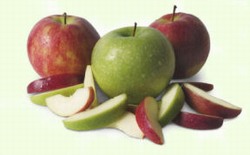 In the fresh-cut fruit sector, it is fundamental to understand the attributes of new apple selections that are important for fresh-cut processing and product shelf-life. Many processors have implemented a temperature conditioning treatment of the fruit before cutting because it has been demonstrated that this practice might reduce damage incurred during the cutting phase. This technique is based on existing knowledge of the differing sensitivity of apple cultivars to bruising injury at varying temperatures. The effect of fruit temperature on mechanical damage response of new cultivars is not well known at the time of commercial distribution.
In the fresh-cut fruit sector, it is fundamental to understand the attributes of new apple selections that are important for fresh-cut processing and product shelf-life. Many processors have implemented a temperature conditioning treatment of the fruit before cutting because it has been demonstrated that this practice might reduce damage incurred during the cutting phase. This technique is based on existing knowledge of the differing sensitivity of apple cultivars to bruising injury at varying temperatures. The effect of fruit temperature on mechanical damage response of new cultivars is not well known at the time of commercial distribution. The objective of the work conducted by Toivonen and Hampson (2009) was to show how the apple quality can change during shelf-life according to the cultivar and the preconditioning before cutting process.
For the work, four cultivars were tested (‘Ambrosia’, ‘Aurora Golden GalaTM’, ‘Granny Smith’ e ‘Royal Gala’). Each of the apple cultivars was harvested at its optimal harvest time and were stored for 3 months in air storage at 1 °C. Then, fruits were removed from cold storage and placed into controlled environment rooms set at 1, 5, 13 and 20 °C for 24 h.
After this preconditioning, the whole fruit was immersed in 5 L of 100 mg/L chlorinated water for 2 min, the clean apples were then sliced. The slices were immersed in 3 L of 100 mg/L chlorinated water for 2 min and then drained for 2 min. The sanitized slices were dipped in 3 L of commercial anti-browning solution for 2 min and then drained for 2 min and packaged.
Fresh-cut apples were stored for 3 weeks at 5 °C. Firmness and soluble solids content were measured on whole apples, while the lightness and the visual quality of cut surface were measured on the day of cutting and after 3 weeks of storage at 5 °C. Visual quality was assessed using a scale from 1 to 9, where the values below 5 indicated off-odors presence, fungal decay, evident deterioration, while values over 5 indicated an acceptable quality of the slices.
Results showed that the firmness of the four cultivars of apples differed at the time cutting. For fresh-cut industry, apple has a minimum firmness standard of 1.94 kg F, below which fresh-cut apples show increased susceptibility to browning and decay. Firmness resulted to decline by increasing core temperature for all cultivars, except ‘Aurora Golden Gala TM’.
‘Granny Smith’ resulted the least firm of the four cultivars tested. The soluble solids levels were not significantly influenced by preconditioning before cutting. Slice color (lightness/ darkness) response was significantly influenced by apple temperature at cutting. After 3 weeks at 5 °C, L-value increased by increasing the core temperature in slices of ‘Granny Smith’, it did not change in slices of ‘Ambrosia’, and it decreased in slices obtained from ‘Aurora Golden Gala TM’ stored at lower temperatures before cutting.
Among temperatures, the highest quality score was for slices obtained from apples at 13°C core temperature. Slices from ‘Ambrosia’ and ‘Aurora Golden Gala TM’ showed a similar response with temperature, slices from ‘Gala’ preserved the best quality when cut from apples at lower temperatures. After 3 weeks, the quality of slices from ‘Granny Smith’ reached an unacceptable level regardless of the core temperature before cutting.
In this work, the results are limited to four cultivars obtained from one growing season at one growing site, thus the authors suggest to use these data with caution because the quality and shelf-life depend on many other factors, such as fruit maturity at harvest, postharvest treatments, storage temperature, duration and storage atmosphere. The present work wanted simply to demonstrate how can change the shelf-life and quality of fresh-cut fruit according to the factors tested.
Original study. Toivonen P.M.A. and Hampson C.R., "Apple Cultivar and Temperature at Cutting Affect Quality of Fresh Slices", HortTechnology, 2009, Issue 19(1), pagg. 108-112. For more details: horttech.ashspublications.org/content/19/1/108.full.pdf








